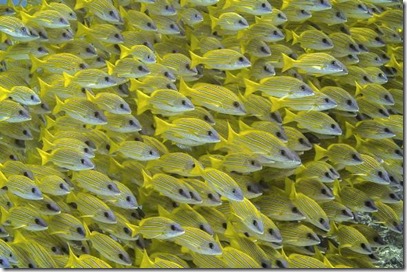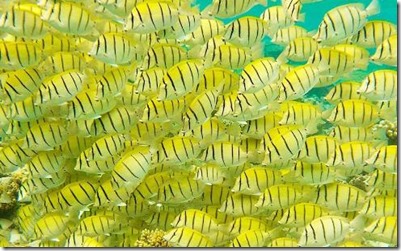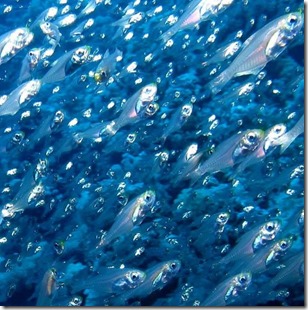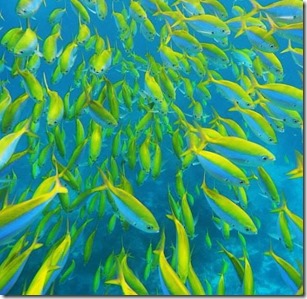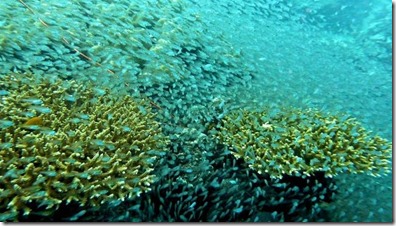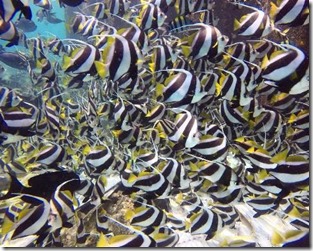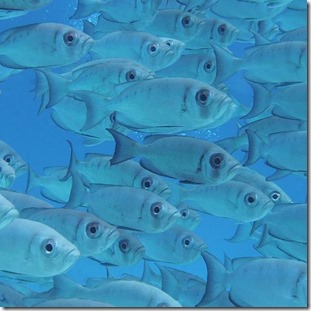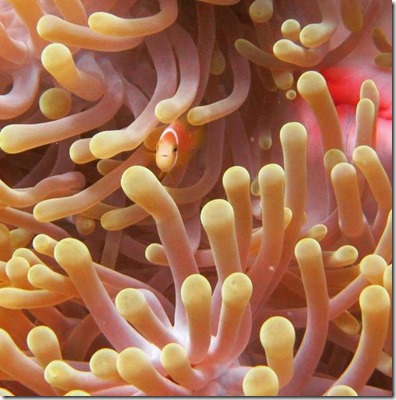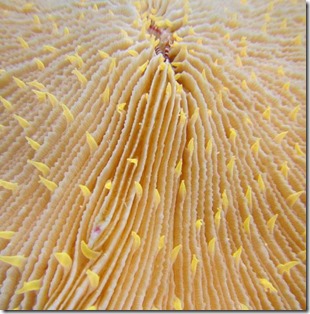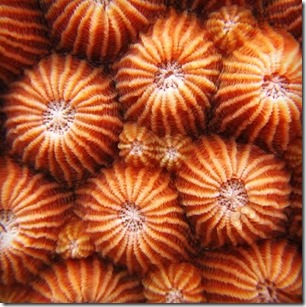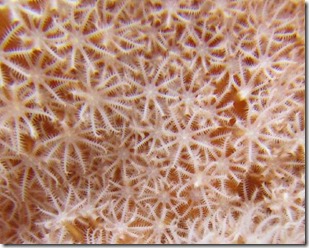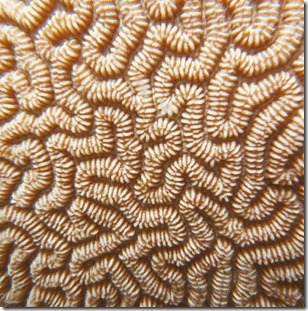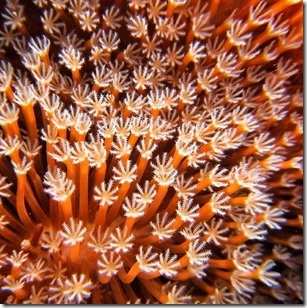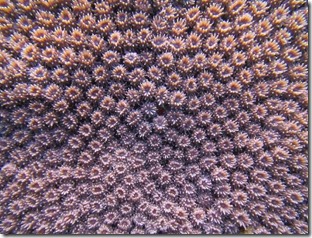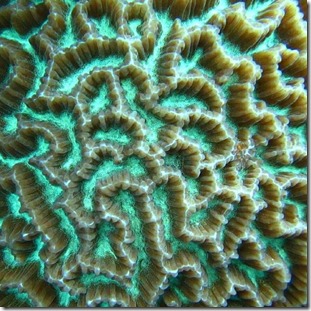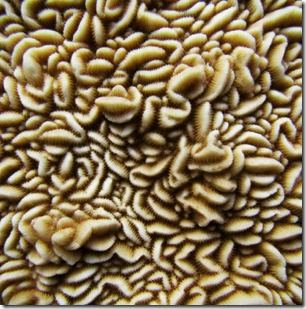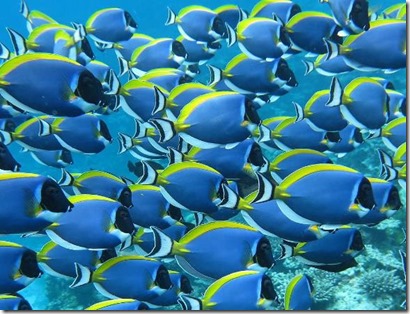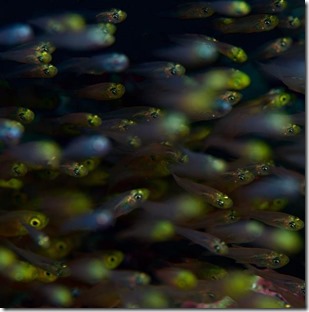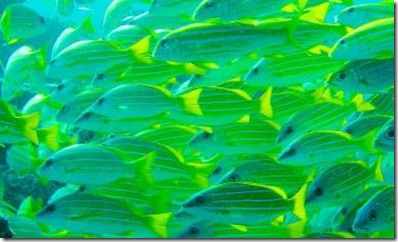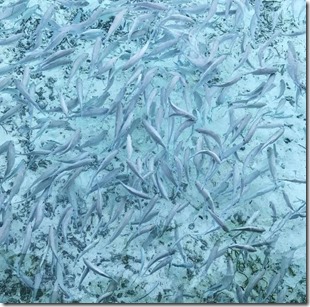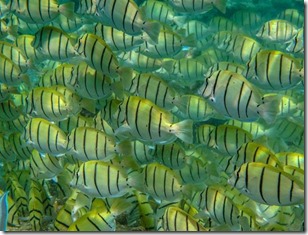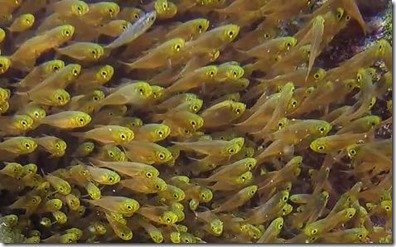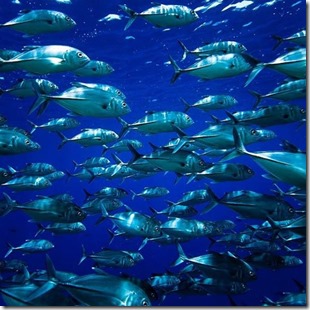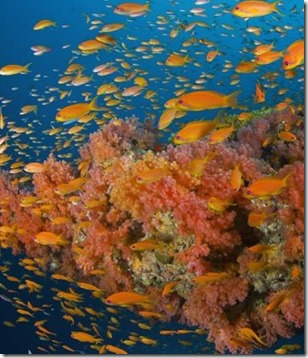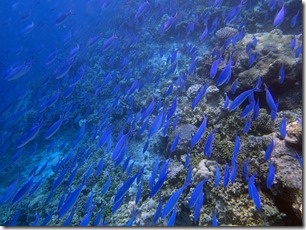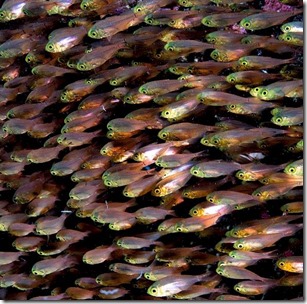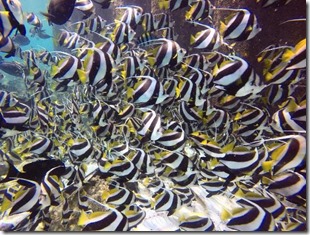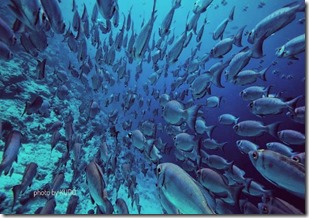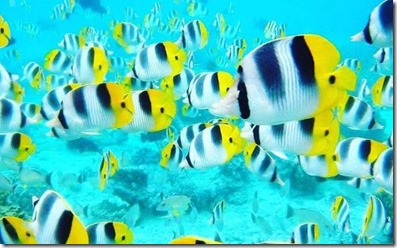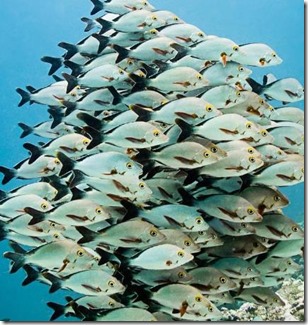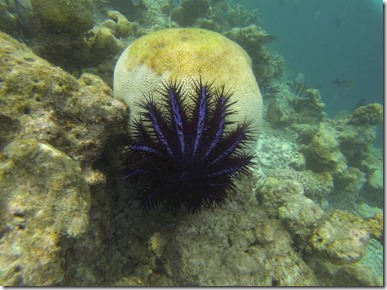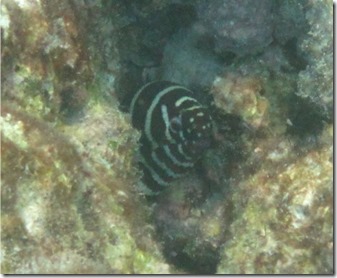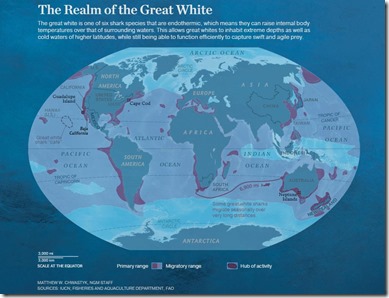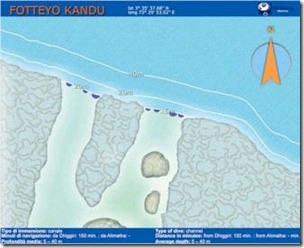The octopus’ Cephalopod cousin, the cuttlefish, is no less intriguing. Itself a clever chappie, they have one of the highest proportions of brain size to body size of all invertebrates. But all the more crazy is that the brain itself is shaped like a donut (a bit of a messed up donut) and the esophagus passes straight through the hole. They must really get serious brain freeze when they eat ice cream too fast!
Back to Schools
Back to school time. So let’s go back to schools Maldive style to mark the season…
- Yellow Striped Snappers [ABOVE]
- Big Eye
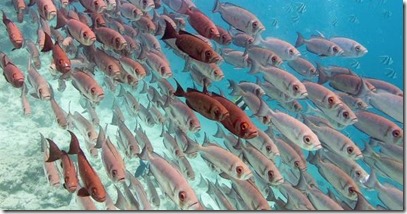
- Snappers
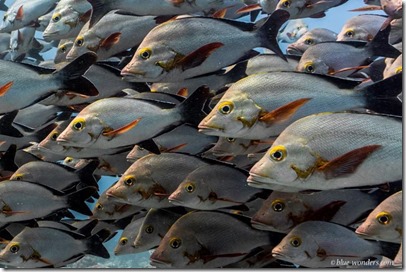
- Head-Band Butterfly Fish
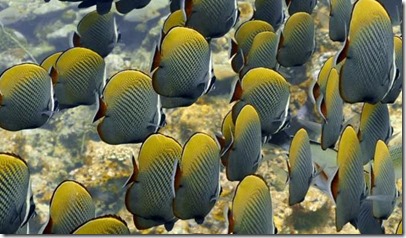
- Moorish Idol
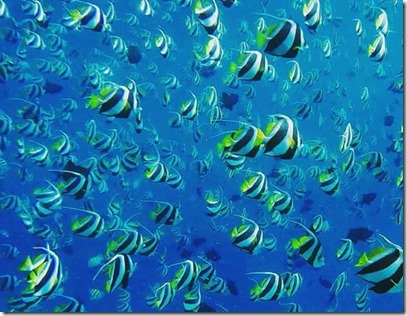
- Blue Surgeonfish
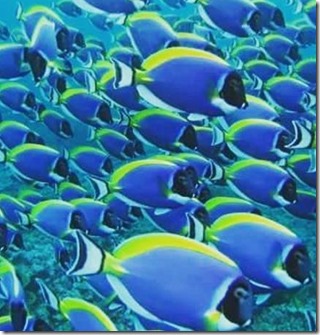
- Yellow Sweepers
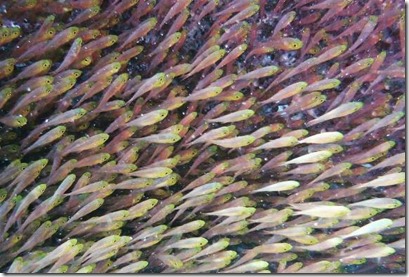
- Glass Fish
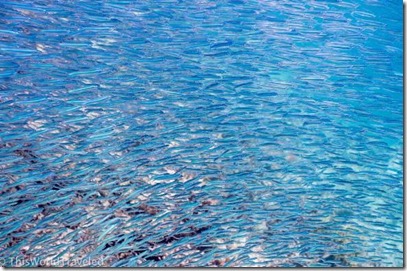
- Convict Tangs
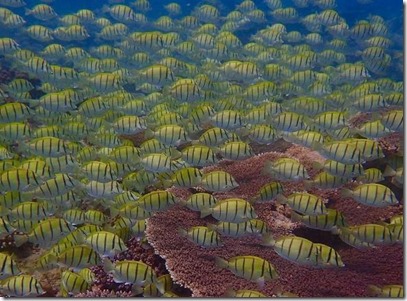
Fish Souper
Second helping of fish soup. Our very first impression of the Maldives was waiting on the airport arrival jetty for our transfer boat and marvelling at the legions of colourful tropical fish scurrying about in the crystal clear water below. While snorkelling, we regularly find ourselves amidst giant clouds of chordata scudding along the top of the coral reefs. Here are more of my favourite close ups of these tapestry-like images forming their own world-class underwater pelotons…
Coral King Tapestries
A of rich and royal hue,
An everlasting vision of the ever-changing view
A wondrous woven magic in bits of blue and gold
A tapestry to feel and see, impossible to hold
– Carole King’s ‘Tapestry’
Dive into the Laccadive Sea and you will be confronted with a living spectacle of vibrant colours and images. It’s tempting just to chase one exciting sight after another. But some of the most biggest displays are to be found in the smallest things. After you see your first Nudibranch, you will be slowing your swimming right down hoping to spot more of these alien slugs. Yesterday’s up close and personal interview with Outrigger Konotta marine biologist Caterina Fattori first stemmed from my admiration of her photographic up close and personal exposés of the coral critters literally make up all of the Maldives islands. To celebrate World Ocean’s Day today, I am featuring my top ten intimate polyp portraits from her stunning Instagram feed…
School of Life
You need cooling
Baby I’m not fooling
I’m gonna send ya
Back to schooling – Led Zeppelin
While the Maldives corals have taken a hit from the warm oceans of climate change and El Nino, the schooling bathing beauties remain as colourful and concentrated as ever. A-fish-ionadoes of the Maldives often refer to the waters as “fish soup” (perhaps an unfortunate term with the excessive water temperatures hitting 30 degrees!). And Instagram has become the digital runway for these fishionista pageants to be shared with the world. My favourite snaps are the one so jam packed with fish that they sort of form kaleidoscopic tapestries of underwater colour (thanks to Verena for help with identifying the more obscure marine models)…
Maldives QI – Part 12
Science Day in nearby India seems like an apropos time for another instalment of Maldives QI. Like all good science teachers, I’m bringing out the video player for special occasions like this. With some lessons about some unexpected swimmers in the Maldives…
- Q: Name a creature that lives in the water but doesn’t move from place to place
- A: Sea anemone?
- Q: Buzzzz! (see above) How about one that lives on land, moves about a lot and doesn’t swim?
- A: Bat?
- Q: Buzzzz! (see below)
Seems like everyone enjoys a swim in the crystal clear waters of the Maldives.
Maldives QI – Oceans Eleven
- Q: What’s the best way to remove coral reef devouring Crown of Thorns Starfish?
- A: Spear them and collect them?
- Q: Buzzz…When a COTS is distressed, by something like being speared, it reacts by releasing its eggs. These number about 10,000 per female. So spearing a COTS just makes it worse.
- A: Poison them?
- Q: Buzzz…Not great to put toxic substances into the marine environment
QI returned to our screens this weekend with “Season N” as in nautical nature news. And today’s Maldives Complete QI instalment on the occasion is just that. Breaking news on the fight against this scourge of the reefs.
Like so many Maldives islands, Kandolhu faced an outbreak of COTS earlier this year and researched a number of methods for effectively solving the problem. The resort Deputy Manager Laura is a trained marine biologist so they had a bit of a ringer in the battle against this reef destroying creature.
One technique she found was injecting bile salts that you could get from Australia. But that was very expensive. Then, they found out that injecting them with vinegar was effective in killing them and was a non-toxic substance. In the end, Kandolhu has removed 9,000 COTS in the past 6 months and appear to have the situation well under control now. We didn’t see a single one in our near circum-navigation of the island.
Best of the Maldives: Eels – Maafushivaru
Probably second to the sharks for looking fearsome and scary are the ubiquitous Maldive morays. The snake-like giant morays are everywhere, but like the sharks are pretty apprehensive creatures and prefer to stay tucked safely in some rock crevice with just their ominous mouth protruding. Often the teeth filled mouth is moving looking like it is practicing biting you (but it’s really just breathing). Occasionally, you will come across the more colourful Honeycomb variety. One snorkel, Lori even came across this baby (about 8 inches long) Zebra moray (see photo above) on the Kurumba house reef.
But we learned about the more extensive diversity of the Moray (or Muraenidae) family of eels during our visit to Maafushivaru. The Marine Biologist Nev held regular night snorkelings so you can see them when they are most active. You go out as sunset when there is still light and then watch the reef get darker as you bring out your torch to spotlight the nocturnal goings on. They have spotted the following morays on the house reef…
- Giant moray
- Yellow Margin moray (mostly at night)
- Zebra moray (mostly at night)
- Undulate moray
- Honeycomb moray
- Clouded moray
- Peppered moray
- White mouth moray
The house reef also features other eels as well including snake eels and cloudy eels.
We also learned that “Honeycomb Moray”, “Leopard Moray” and “Tessellate Moray” and “Laced Moray” are all monikers for the same species, Gymnothorax favagineus.
“When you’re at the Maldives with lots of eels in the sea, that’s a moray. When you’re at Maafushivaru and the eels are in view, that’s a moray…” ♫♪
Maldives QI – Part X
…for “X” marks the spot where in the world the Great Whites are.
Q: When was the last shark attack in the Maldives?
A: A year ago?
Q: Buzzzzz! No. The Maldives have never had a recorded shark attack on a human.
World Tourism Day today and the Maldives stand tall (much taller than its famously low elevation) among the titans of the travel industry as a bucket list destination. And for selachophiles, the bountiful populations of a range of shark species is one of the many oceanic attractions.
Still, for a few of the more aquatically apprehensive, all these dorsal fins can evokes a number of cinematic fears brought on by everything from Jaws to Deep Blue Sea and Thunderball. In fact, nearly all species of shark keep quite a distance from diving and swimming humans. When you spend some time diving and snorkelling with them, you quickly figure out how they are the scaredy-cats of the ocean turning and fleeing at the least disturbance.
In most cases, these cartoonishly portrayed “man-eaters” are the species “Great White”. And if sharks’ docile temperament isn’t enough to re-assure you then, you can at least travel to the Maldives knowing that you won’t encounter any Great Whites. Great Whites are found pretty much all over the world east-to-west, and north-to-south. But there is one place they don’t hang out in and that’s the Indian Ocean (except for a patch off the coast of east Africa).
Best of the Maldives: Longest Reef – Alimatha
While the Maldives might have limited links land above sealevel, it’s undersea world is an expansive wonderland. And the most expansive of them all is the Fottheyo reef in the Vaavu atoll…
“We all know that Australia has the Greatest Barrier Reef in the World, but how many of you know, which one is the Greatest One in Maldives in terms of square kilometres?! The biggest one is Fottheyo Reef in Vaavu, with its 68 SQ KM.”


